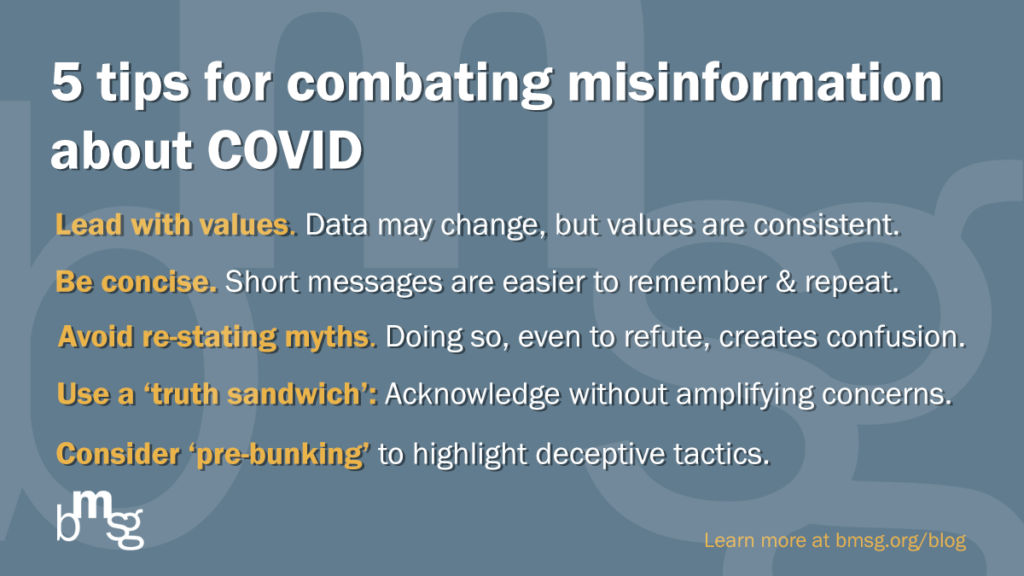Five ways public health advocates can combat misinformation when communicating about COVID
by: Vivian Taina
posted on Thursday, January 13, 2022
Something’s burning. It was September 9, 2020, and I had just awakened to an orange sky. It was too bright for 6:30 a.m. in San Jose, so I sniffed, not believing my eyes. But that only made things worse. The faint whiff of saltwater I relied on for familiarity was gone. As I got online, I saw urgent messages from my coworkers: Massive fires had broken out in California, and we had to decide — very quickly — whether or not to ground our canvassing team.
Was the air quality bad? I wondered. How bad is too unhealthy for everyone?
Should we be responding to the fire, or the pandemic?
It was only the third week of the Community Health and Business Engagement program, a small team conceived by my local county to distribute information on mask wearing and social distancing during the pandemic. Most of the time, we were being crushed by questions we couldn’t answer. Is my business eligible for a loan? I heard that the funds have dried up already. My customers don’t want to wear masks because they don’t believe COVID exists. The fires were an unwelcome element puffing in more uncertainty.
As the twin threats of COVID and wildfires grew, so did a third danger to our community: misinformation. Certainly, it is less tangible than a virus or smoke-filled air, but its risks to health are no less real. Not only are misinformation and disinformation fueling vaccine hesitancy, they are also discouraging communities from seeking out services that could improve their lives. A recent report from the Surgeon General cements this: Addressing misinformation is a public health imperative. As advocates seek to address misinformation at the root by holding tech companies accountable, we also need tools to neutralize bad information during the pandemic and in the future.
The first step toward combating misinformation is understanding how people spread it, sometimes without even knowing it. Misinformation and disinformation often begin with people and corporations deliberately twisting facts, even profiting from those lies. However, those same distortions can be amplified by well-meaning people.
How, then, can public health advocates and practitioners avoid unwittingly fueling the spread of misinformation? The following is a primer to this large topic — five pieces of advice to communicate more effectively amid our current environment:
Lead with values.
Across all areas of public health, our messages are strongest when they incorporate, and ideally lead, with values. With COVID, community organizations and health departments have to contend with rapidly evolving science. As the details quickly change, people may feel the information coming from public health is less reliable, opening them to believing misinformation. To be sure, it is difficult to remain credible when guidance frequently changes. Leading with overarching values that resonate with community members provides some consistency in messages even when specific details shift.
Be concise.
It may be tempting to say everything, especially as we know more today regarding COVID, but shorter messages are easier to repeat and remember. If practitioners don’t create strategic and concise messages, their communities will likely tune them out in favor of ones that make their audiences feel included. Keeping our messages concise can also make it easier to identify our own jargon, which can make it harder for people to understand messages. If our messages are brief, it’s easier to flag — and remove — the terms that might be hard to understand.
Avoid re-stating myths or opposition talking points.
Experts agree that putting bad information to rest by repeating it, such as stating myths and facts, is tempting but can backfire. Even if our language is clear, people may recall information out of order, miss important nuances, and remember the myths rather than the facts provided to replace them. To avoid unintentionally amplifying myths and misinformation, try reframing the facts. For example, after hearing that “vaccines are not in short supply,” people may later remember only “short supply” and not recall whether this is or isn’t the case regarding vaccines. Instead, try stating the frame you want people to remember: “We have an ample supply of vaccines.” Social media posts can skip stating the myth and focus on the facts, values, and frames that are most important.
Use a ‘truth sandwich.’
If you feel you must acknowledge misinformation, a tried-and-true tool is the truth sandwich, which acknowledges people’s concerns without reinforcing them, such as in the case of masks. This approach ‘sandwiches’ the misinformation between the truth:
1. Start with the truth. The first frame gets the advantage.
2. Indicate that some people are spreading misinformation. Avoid amplifying the specific language if possible.
3. Return to the truth. Always repeat truths more than the misinformation.
Pre-bunk misinformation.
Within the truth sandwich, there is also an opportunity to proactively debunk if you know how misinformation is going to surface. If that is the case, then “pre bunking,” or warning your audience about suspect sources and reasoning, can prepare members of the community to have a more critical eye toward misinformation. Pre-bunking is similar to a truth sandwich but may be best suited for occasions when public health practitioners are involved in ongoing discussions with a group and have the time for longer, more in-depth discussions. For example, the Virality Project developed a blog in the earlier days of the pandemic that highlighted the deceptive tactics and types of misinformation it expected the public to see around the vaccine rollout.
Practitioners can adapt this approach to address other types of misinformation as well. However, for a quick quote to a reporter, or social media posts, sticking with concise, values-forward messages that avoid repeating the opposition are still the strongest option.

Are there strategies you’ve used to fight misinformation within your public health campaigns and/or community outreach initiatives? We’d love to hear from you. Email us at info@bmsg.org or tweet to us @BMSG.



